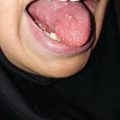, Ahmad Ameri1 and Mona Malekzadeh2
(1)
Department of Clinical Oncology, Imam Hossein Educational Hospital, Shahid Beheshti University of Medical Sciences (SBMU), Shahid Madani Street, Tehran, Iran
(2)
Department of Radiotherapy and Oncology, Shohadaye Tajrish Educational Hospital Shahid Beheshti University of Medical Sciences (SBMU), Tehran, Iran
The rectum is the most affected organ during pelvic radiation therapy because of its fixed position in the central part of pelvic cavity [1]. Acute radiation proctitis occurs in more than 75% of the patients during pelvic radiation therapy [2]. Treatment interruption due to severe acute radiation proctitis has been reported in 10–20% of patients undergoing pelvic radiation therapy [3, 4].
17.1 Mechanism
Radiation-induced acute colorectal injury involves all mucosal compartments including the epithelium, goblet cells, and lamina propria.
Mitotic arrest occurs in rapidly proliferating epithelial stem cells in mucosal crypts and leads to cell depletion; shortening, narrowing, and loss of crypts; eroded surface of epithelium; and mucosal break down. Inflammatory cell infiltration of the epithelium by neutrophilic and eosinophilic cells occurs. Cryptitis due to neutrophil infiltration through the crypt wall and crypt abscesses by eosinophil accumulation develop. The number of goblet cells is reduced, and glandular atrophy occurs. Significant inflammation of the lamina propria with vessel congestion occurs and leads to hyperemia, edema, and ulceration [5–7].
Inflammatory mediators including eicosanoids are induced in the rectum as an early response to direct radiation injury or secondary to mucosal damage and lead to an increase in inflammatory cell infiltration and activation, capillary permeability, and proctitis severity [8].
17.2 Risk Factors
Several patient-related factors have been reported to be associated with acute radiation proctitis like patients with younger age (less than 60 years) [9], presence of hemorrhoids, diabetes [10], and inflammatory bowel diseases [11] (see Chap. 15).
Treatment-related factors including multiple radiation dosimetric factors (like the percent volume of rectum receiving more than 30, 35, and 60 Gy, mean rectal dose, the percent volume of anal canal receiving 15 Gy, the rectal length irradiated to doses of 5 Gy, and more) [9, 10, 12] and concurrent chemotherapy are proposed as factors related to probability of acute radiation proctitis [13].
17.3 Timing
17.4 Symptoms
Acute radiation proctitis manifests by increased frequency and urgency of defecation, rectal pain, tenesmus, mucous discharge, and less commonly bleeding and fecal incontinence [3, 15]. Fecal urgency and incontinence are associated with alterations in sphincter function and reduction in the minimum basal and mean squeeze pressures in anorectal manometry [3]. Preexisting patient symptoms or medical conditions may be worsened during radiation therapy. Preexisting hemorrhoids may be inflamed and exacerbate patient symptoms.
Perianal skin reactions occur in patients with this area present in radiation portals that presents with the skin changes that are discussed in Chap. 1.
17.5 Scoring
Radiation Therapy Oncology Group (RTOG) and European Organization for Research and Treatment of Cancer (EORTC) radiation toxicity grading classify all symptoms related to the lower gastrointestinal tract in a single scoring category (Table 17.1) [16].
Table 17.1
RTOG/EORTC radiation toxicity grading for lower gastrointestinal tract
Definition | |
|---|---|
Grade 1 | Increased frequency or change in quality of bowel habits not requiring medication/rectal discomfort not requiring analgesics |
Grade 2 | Diarrhea requiring parasympatholytic drugs (e.g., Lomotil)/mucous discharge not necessitating sanitary pads/rectal or abdominal pain requiring analgesics |
Grade 3 | Diarrhea requiring parenteral support/severe mucous or bloody discharge necessitating sanitary pads/abdominal distention (flat plate radiograph demonstrates distended bowel loops) |
Grade 4 | Acute or subacute obstruction, fistula, or perforation; GI bleeding requiring transfusion; abdominal pain or tenesmus requiring tube decompression or bowel diversion |
Common Terminology Criteria for Adverse Events (CTCAE) version 4.0 classifies proctitis (either acute or chronic) into five grades (Table 17.2) [17]:
Table 17.2
CTCAE v4 proctitis grading
Definition | |
|---|---|
Grade 1 | Rectal discomfort, intervention not indicated |
Grade 2 | Symptoms (e.g., rectal discomfort, passing blood or mucus); medical intervention indicated; limiting instrumental ADL |
Grade 3 | Severe symptoms; fecal urgency or stool incontinence; limiting self-care and ADLs |
Grade 4 | Life-threatening consequences; urgent intervention indicated |
Grade 5 | Death |
17.6 Prevention
Intensity-modulated radiation therapy (IMRT) can reduce the irradiated volume of the rectum and improve acute radiation-induced proctitis compared to 3D conformal radiation therapy (3DCRT). However, dose-volume parameters do not significantly change in rectal cancer treated with IMRT because of large volume of rectum included in target volume of treatment fields [18–25].
Amifostine can reduce acute radiation-induced proctitis in patients receiving pelvic radiation therapy and is recommended at a dose of ≥340 mg/m2 intravenously to prevent radiation proctitis [26, 27]. Intrarectal and subcutaneous application of amifostine also have been reported to be effective alternative routes to the intravenous amifostine in protection against acute radiation-induced rectal damage [28–30].
Investigational methods including injecting hyaluronic acid [31, 32] and human collagen [33] in the perirectal fat as well as insertion of an inflatable balloon applicator into the rectum [33, 34] have been proposed in prostate cancer radiation therapy to increase the distance between rectum and prostate and consequently decrease the radiation dose of the anterior rectal wall and proctitis.
Sucralfate is a nonabsorbable basic aluminum salt of sucrose sulfate that has been proposed in prevention of radiation-induced proctitis due to its cytoprotective properties, angiogenesis and epithelial proliferation improvement, protection of denuded mucosa, and binding bile acids; however, several studies did not find substantial benefit of oral or rectal sucralfate in the reduction of acute radiation proctitis symptoms [35, 36].
Rectal misoprostol, a prostaglandin E1 analog, is another agent that is evaluated as a radioprotection of acute proctitis and provides mixed results in related studies [37, 38]. It has been shown that rectal hyaluronic acid (HA), a major mucopolysaccharide, can reduce epithelial cell death and provide a positive effect on radiation proctitis [39].
Aminosalicylate compounds including prodrugs (sulfasalazine and balsalazide) or active (mesalazine) agents have anti-inflammatory properties due to their ability in inhibition of inflammatory mediators and cells. Balsalazide converts to active form by colonic bacteria after oral administration with minimal systemic absorption and has more efficacy in patients with more distal colon disease due to a high concentration of active drug to the distal compared to other oral agents like mesalazine [40]. It has been suggested that oral balsalazide is able to prevent or reduce symptoms of radiation proctitis in patients undergoing irradiation for prostate cancer [41]. Rectal mesalazine did not show any prophylactic effect on radiation-induced proctitis during radiation therapy for prostatic carcinoma [42].
Nonsystemic glucocorticosteroids, such as beclomethasone dipropionate (BDP), have been suggested as efficient agents for the prevention of radiation-induced proctitis due to their anti-inflammatory properties and safer pharmacokinetic profile compared with systemic agents. Further studies are needed to confirm these primary promising results [43].
Clinical use of prophylactic sucralfate, misoprostol, HA, balsalazide, mesalamine, or BDP for radiation proctitis protection cannot be recommended based on current results.
Butyrate enemas have not shown any benefit given for the prevention of acute radiation proctitis [44].
Fecal calprotectin and lactoferrin are two indicative markers of intestinal inflammation that are released by migrated intestinal neutrophils [45, 46]. It has been shown that the fecal levels of calprotectin and lactoferrin increase during pelvic radiation therapy and are associated with acute radiation proctitis in non-colorectal cancers [47–49]. Increased fecal calprotectin and lactoferrin levels in colorectal cancer limit their use as a diagnostic marker in this setting [50, 51]. Another marker proposed in this regard is human DNA concentration that is excreted in feces due to epithelial cell damage [51]. These factors are promising tools that allow monitoring mucosal damage and treatment modification with the aim of acute injury prevention.
17.7 Management
Acute proctitis can be treated with dietary modification, topical agents, and/or cessation of treatment in severe cases.
Fecal urgency or incontinence can be improved by dietary modification. Patients should be encouraged to have adequate soluble fiber (e.g., fruits without skins, oat, bran, barley) in their regulatory diet. Dietary fiber increases stool bulk and enhances stool consistency and viscosity [52]. Treatment of concomitant diarrhea may help to control fecal urgency or incontinence. All dietary modification and medications that are discussed for treatment of diarrhea in radiation-induced enteritis (Chap. 15) could be effective in improvement of these patients’ symptoms. Loperamide is particularly useful in this setting due its positive effect on anal sphincter pressure that helps in stool continence [3, 53, 54].
Current data support using of butyrate as an effective medical treatment of acute radiation proctitis. Butyrate enema (80 mL once per day or enemas of 40 mL twice daily) can improve patient symptoms. Butyrate, a distinct form of short-chain fatty acid, is the major energy source for colonocytes and provides a trophic effect on colonic mucosa by enhancing epithelial cell proliferation and differentiation [55–57].
Stay updated, free articles. Join our Telegram channel

Full access? Get Clinical Tree





